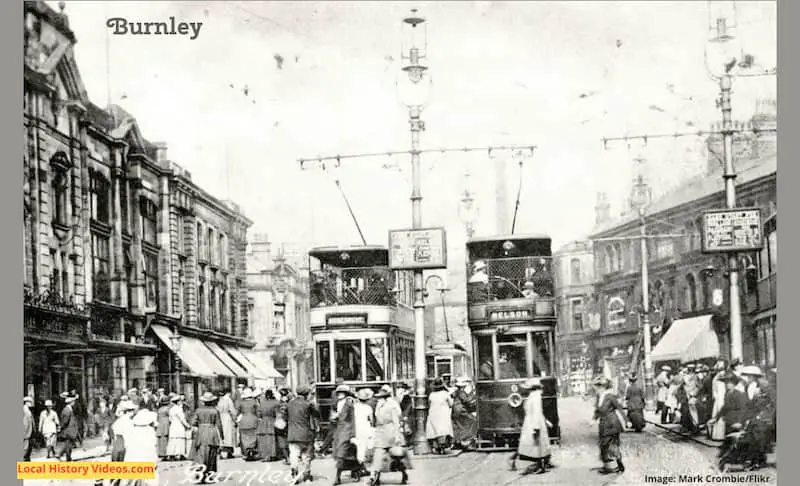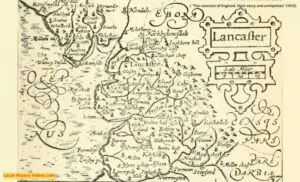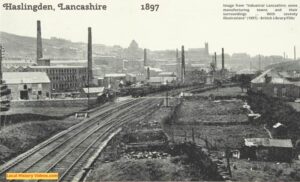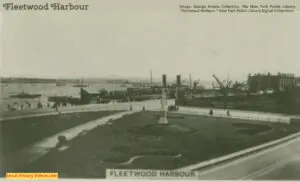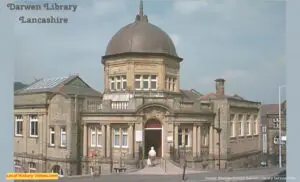Glimpse history through old images of Burnley, Lancashire, England, UK.
Factories In Burnley’s History
Factories were first built in Burnley during the Industrial Revolution. The meeting point of the River Calder and the River Brun provided an ideal location for harnessing water power to drive the new spinning machines which revolutionised the way cotton was produced.
By 1911, the town held 99,000 power looms and was both a major production centre and an important centre of employment.
The town was home to more than 100,000 people that year, when a total of 45million people lived across the whole of the UK.
While today it has some of the lowest average house prices in the country, Burnley’s population is lower now than it was in 1911. In 2020 the town has approximately 88,000 current residents, despite the UK population growing to almost 68 million people.
The town saw the closure of the last deep coal mine, the Hapton Valley Colliery, in February 1981. A year later, the last steam-powered mill, the Queen Street Mill, ceased production. BEP, Prestige and Michelin were three of the town’s major manufacturers who also closed their doors over the next two decades. Manufacturing now accounts for just 16% of local employment.
1960s Burnley Factory Workers
In the 1960s the factories of Burnley were still busy producing a wide range of goods and providing a major source of employment to local people. A short film made at the time and now held in the Kinolibrary Archive Film Collection shows Burnley’s factory workers busy in their labours.
The 16mm short film displayed above was made during the 1960s. Lasting just under 5 minutes, it is silent but shown in colour.
1960s Factory Workers in Burnley, HD, from 16mm – Kinolibrary on YouTube
Events shown in the film include:
- Looms making cloth under human supervision
- Pairs of women folding large towels and blankets
- The Mullard factory at Simonstone, producing television tubes
- The production and packaging of lozenges
- The Michelin factory in Burnley
- Factory lunchtime in the canteen
- Women and men working on different production lines
- An engineering factory school, where young men learn skills
- A Lucas factory, which employed around 7,000 people across its Burnley sites
Despite its short length, this footage shows dozens of men and women working hard in Burnley’s factories. Their ages range from teenagers through to people approaching retirement.
As much as people concentrate on the task in hand, there are frequent glimpses of smiles and laughter between work colleagues.
This film provides a small glimpse into a working class world which is largely gone. Some of the people shown may never have been filmed before or since.
Burnley Buses
1987
BURNLEY BUSES 1987 – DaveSpencer32 on YouTube
1989
BURNLEY BUSES 1989 – DaveSpencer32 on YouTube
1994
BURNLEY BUSES 1994 – DaveSpencer32 on YouTube
Historic Book
Extract from “Tales of the Brun, etc“, by George Hindle
Published in 1896
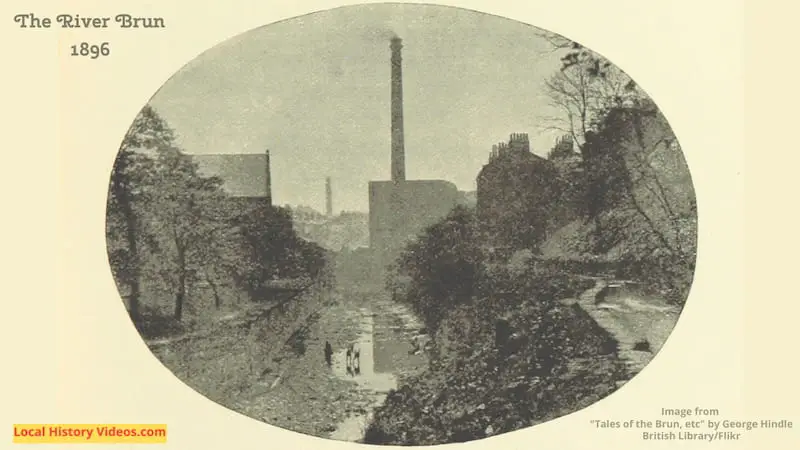
Pages x & xi
“Of Burnley as I know it , I will speak. When a child of six years of age I first entered it , emigrating with my parents from the Vale of Irwell in the Rossendale Valley.
Cocklestone pavements were then the order of the day. The song of the lark and the clanging of the town-crier’s bell were contemporary sounds. The perfume of wild flowers and new – mown hay floated through the streets. Warm milk fresh from the cow met the eyes of the growing lad and lass who had already accomplished two hours ‘ work since the dawn of day.
Blackberries grew a very little distance from the school-house door, and were far more fascinating than the lessons taught in the latter. School Boards were unheard of then, the only inducement to education offered by the Governments of that day being a capitation grant, and there was no compulsory attendance, though a regular attendance at school generally earned a prize or some sweetmeats from an indulgent parent, and the blackthorn tanned the hide of the truant.
The ‘ packhorses ‘ appeared twice a day with their burdens of quicklime, and as oft did the coming constable cast his shadow along the streets to the infinite terror of the juveniles, who fled whether right or wrong.
This was the Burnley I found just previous to its incorporation in 1861.”
Pages 120 & 121
“Many shops in the Burnley of that day were without gas, a candle had to light the shop, and another might be placed on a shelf, which would throw off a sickly glare, and sometimes the candle would be hid behind bottles of toffee-sticks, acid drops, or gingerbread animals.
How much different is the Burnley of today? The sickly candle has given place to cheerful gaslight, which it is probable ere long will be superseded by the powerful light produced by the electric motor.
The shops, too, are larger, and more elegant, and of the many articles sold in them, some were perhaps unheard of in the days of which we write. Nothing is thought to-day of a youth wheeling home a bicycle, or taking home a piano, an American organ, or harmonium, the gifts of perhaps his father or uncle, or some other relative or friend. About the time of which we write, a concertina, flute, or accordian, would have been deemed a grand present, the recipients of which would suddenly develop a liking for music, and not without success in a great many instances.
The streets of old Burnley have altered, and that for the better. St. James’ Street and Church Street have been made wider the whole length. These streets might be said to divide the town in halves. The town has grown bigger and more compact, and the new
streets alone out-number many times over the streets then existent.
The old Wesleyan Chapel at Keighley Green still stands, but the precincts are more frequented by lawyers than ministers, having long since been converted into a courthouse by the county authorities.”
“Here were the headquarters of the newly-formed Wesleyan circuit in 1810. On the other side of the road was the Wesleyan school, now used as a drill-room by the Volunteers, and over which was a sign which read “For children of all denominations.”
In this school , seventy – five years ago, a Burnley gentleman, prominent in the Wesleyan body, was learning the alphabet in what was called a sand class. What was meant by
that was, the pupil was taught to shape letters with a stick in sand which was spread on a table in front of him. Such was the mode of education in those days.
Spencer and Moore’s mills have been erected since then, but the old mill still standing in Massey Street (sometimes called Dandyshop Street) bears the date 1787 on the keystone of the arched door in the same street.
Of the few mills then erected fewer now remain, and this may be said of many mills erected at a later date, such as Tunstill’s, Newtown; Kippax’s, then run by Pollard; Mrs. Howarth’s, higher and lower mills. The latter, used as a lecture-room for some time, was destroyed by fire some dozen years ago. The former, which served as a theatre for a long time, shared the same fate. Kippax’s in Salford, was also the scene of a conflagration in the early part of last year.
Whilst stand ing here in the main street, Slater’s factory can be seen high up on the hill in Sandy Gate . Lofty is her clocktower, and elevated is the mill. She might be a little
proud to be able to overlook all others, and perhaps forgetting that she, like her humbler neighbours, was once humbled to the dust, and that too by the same fiery element a circumstance occurring late one Saturday night, and one which will still linger in the memories of many Burnley people.
All the mills mentioned were working at the time of which we write, the workpeople engaged in them residing chiefly in the Meadows, Club Houses, or Salford districts, in which districts the houses and streets remain much the same.”
More about Lancashire
- Old Images of Lancashire, England
- Old Images of Skelmersdale, Lancashire
- Old Images of Haslingden, Lancashire
- Old Images of Fleetwood, Lancashire
- Old Images of Darwen, Lancashire
.
Back to Lancashire page
Back to Local History Videos Home page

